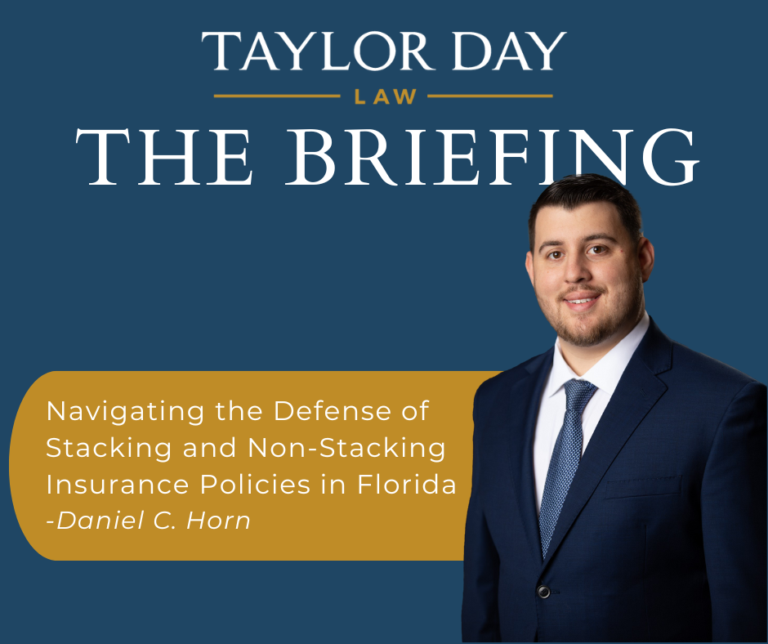Understanding how stacking and non-stacking insurance policies operate is critical for defending Florida’s uninsured/underinsured motorist coverage claims. Stacking allows an insured to combine coverage limits from multiple vehicles or policies, thereby increasing the total available payout for uninsured/underinsured motorist claims. This coverage provides policyholders with broader coverage but also creates complexities in litigation, particularly when multiple policies are issued with both stacking and non-stacking provisions to the same insured. This article examines the key legal principles surrounding stacking in Florida, the governing statutory framework, and strategies for defending claims involving these policies.
With a stacking policy, a policyholder insuring two vehicles, each with $100,000 in uninsured/underinsured motorist coverage, could combine the limits to access $200,000 in total coverage for a covered claim. However, Florida law prohibits the stacking of non-stacking policies, or policies without uninsured/underinsured motorist coverage, with policies that allow stacking, even when issued by the same insurance company and in effect at the same time. If an insured holds a combination of stacking and waived or non-stacking policies—such as one policy with stacking coverage and another where uninsured/underinsured motorist coverage has been explicitly waived—the insured can only stack the limits of policies with stacking provisions and uninsured/underinsured motorist coverage. Any non-stacking policies, or policies lacking uninsured/underinsured motorist coverage, should be excluded from the calculation of the total available coverage. In Florida, stacking of uninsured/underinsured motorist coverage is therefore only permitted when a policyholder has multiple policies with uninsured/underinsured motorist coverage and no valid waiver of stacking on those policies.
This issue has been addressed in several cases in Florida. In Coleman v. Florida Insurance Guaranty Association, Inc., 517 So. 2d 686 (Fla. 1988), the Florida Supreme Court clarified that stacking is determined based on the number of coverages for which the insured actually paid premiums for such coverage, not the number of vehicles owned. Similarly, in Swan v. State Farm Mutual Automobile Insurance Company, 60 So. 3d 514 (Fla. 3d DCA 2011), the court reinforced this principle, emphasizing that only policies with premiums paid for uninsured/underinsured motorist coverage contribute to stacking. These rulings highlight the importance of thoroughly examining policy language and payment records to evaluate an insured’s stacking rights when defending a claim.
Consider the following practical example: a policyholder insures three vehicles under separate policies with the same insurer. Two policies include uninsured/underinsured motorist coverage with stacking provisions, while the third policy expressly waives uninsured/underinsured motorist coverage through a valid selection/rejection form. The insured is involved in an accident caused by an uninsured driver and seeks to stack the limits of all three policies. In this scenario, the insurer can successfully argue that the coverage is limited to the two stacking policies, with the third policy excluded due to the valid waiver of uninsured/underinsured motorist coverage. This defense hinges on the clarity of the waiver language and a clear allocation of premiums actually paid. A proper understanding of Florida Statute § 627.727, which governs uninsured/underinsured motorist coverage, is also critical in defending stacking claims in Florida. In Coleman, the court declared certain policy language invalid and relied solely on the express statutory requirements to determine whether the relevant policies stacked in that case. This again highlights the necessity of ensuring that policy selection/rejection forms are drafted in a way that aligns with Florida Statute § 627.727 and that they reference specific policies, not vehicles. Such precision can prevent ambiguities and bolster the insurer’s defense in litigation.
In conclusion, defending claims involving stacking and non-stacking policies in Florida requires a nuanced understanding of the policy language, statutory requirements, and relevant case law. Lawyers at Taylor Day Law carefully analyze whether premiums were paid for uninsured/underinsured coverage and whether valid coverage waivers exist. By understanding policy documents and staying abreast of legal developments, insurers and attorneys can effectively protect their clients from unwarranted and improper stacking claims in all stages of litigation.

